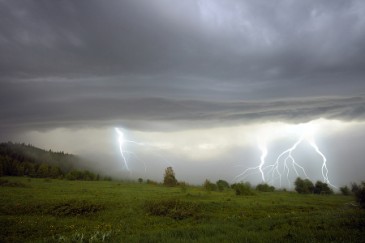The Weather and Your Mood

How much does the weather really affect your mood?
by Jennie Wood
 |
Related Links |
You've heard the term Seasonal Affective Disorder. You also know that exposure to sunlight provides vitamin D, which affects hormone levels and, therefore, moods. You've sat inside on a gloomy, rainy day, annoyed that your plans were washed out. But how much does the weather really affect your mood?
Research has proven that warm temperatures and exposure to sunshine have the greatest positive impact on moods. A report published in the British Journal of Psychology found that warmer temperatures lowered anxiety and skepticism while more hours of sunshine increased positive thinking. The same study showed that high levels of humidity made it hard to concentrate, increasing fatigue and sleepiness.
Seasonal Affective Disorder
Seasonal Affective Disorder (SAD), the clinical name for winter depression or the winter blues, occurs due to the temperature drop and the short days during the winter months. Symptoms include depression and excessive eating and sleeping. Some people with SAD gain weight due to over-eating and inactivity. Women suffer from SAD up to three times more than men.
There are ways to treat SAD. Maintaining a regular schedule, especially sleep, is the most important factor. Exercise and exposure to natural light are also factors for keeping the winter blues at bay. Taking daily walks and sitting next to windows at home, work or in class can help. Putting your bedroom lights on a timer so that they come on before you wake up (like the sun rising) can help maintain a sleep schedule. In addition, there are special "warm" lights available for fighting seasonal depression.
The Weather and Allergies
Seasonal and year-long allergies can interrupt your sleep and daily routine, which greatly affects your mood. The weather also has a direct impact on allergies. Wind, rain, extreme temperatures, humidity, and air pollution can make allergies worse. Strong winds spread pollen and mold far and wide. High winds blow tree pollen in the spring and ragweed in the fall into the eyes, nose, ears and mouth of allergy sufferers, increasing exposure. A mild winter is great if you don't like cold weather, but it usually means early pollination for trees and flowers, and therefore, an earlier, heavier allergy season. Rain can help wash away allergens when trees and plants are pollinating, but rainy winters and autumns typically increase pollen counts in the following spring. High humidity levels create more growth in mold spores, thus causing more allergy symptoms. Cold temperatures, however, can provide great relief to allergy sufferers. During the spring, sudden drops in temperature can freeze tree pollen production. In the fall, ragweed season ends with the first frost.
There is relief for allergy suffers. Along with the myriad of over the counter and prescription medications, there are other remedies. Local, raw honey helps control allergies. Make sure you get honey that's local so the bees have used the same plants and grass you're having an allergic reaction to. Daily use of a neti pot for nasal irrigation also helps control allergies. Neti pots are available at most drug stores.
Research has shown that the weather does have an impact on how we feel. Whether it's cold temperatures bringing on the winter blues or heavy winds blowing tree pollen around during the spring, the weather does play a part in your health and mood.
Source: British Journal of Psychology, Association for Psychological Science, American Academy of Allergy, Asthma, & Immunology.
